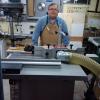I know, large drill presses shouldn't be mobile, but that's what I need. I have the large Delta 19" press. I only use it about ever two weeks but when I do I need about 4' in 180 degrees around it. I can't afford that much shop space when it's sitting idle. I also don't have a good place where it can "share" the open space with other equipment. When I bought it the manual said it needed to be bolted to the floor or mounted to a board of a certain size. I ended up building a box 24" wide by 30" deep by 6" tall as I'm 6'3" and wanted the extra height anyway. It did sit in one place for a long time, but my work has changed and I got a sliding table saw in December that's forced me to rearrange things.
What I've done for now is add two fixed casters on the back SIDE of the box that are just off the floor. On the front center I put a step down caster. Now it works like a lot of router tables and Grizzly's built in mobile base on their jointers and planers. You step down on the front caster and it lifts the box just off the floor and onto the two back casters. The problem is my shop floor is far from flat and when I move it from my work area to my "equipment parking lot" it gets hung up on high spots. Nothing I can't manage, but irritating and a little nerve racking considering how top heavy it is anyway.
I could re-do the back casters so it sits on them all the time, but then it's less stable when it's in use and I'm afraid they'd get flat spots considering how much it weighs and how long it sits at a time. I've thought about four heavy duty double locking casters, but seems a little risky.
Has anyone else come up with a good mobile base for a large drill press that would care to share ideas and pictures? Thanks in advance.




 Reply With Quote
Reply With Quote








